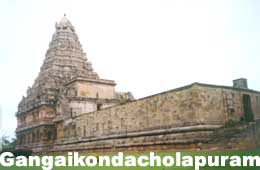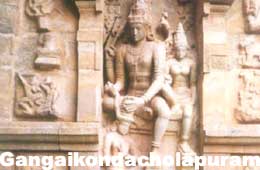| India Profile » Monuments and Temples in India » Gangaikondacholapuram | |
Gangaikondacholapuram, Tanjore | |
 | |
|
The temple was built during the period, which can be described as the 'golden age' of the Cholas. Rajendra Chola inherited a vast reserve of wealth from his father. The Cholas were invading and conducting successful campaigns in the northern territories of India. Rajendra Chola conquered Madurai and Ellam.During one of his campaigns to the north, Rajendra Chola brought the water from the Ganges River in a golden pot and sanctified the reservoir of Ponneri or Cholaganga. As a result, he was given the title of 'Gangaikondan' meaning 'The One who Brought the Ganges'. The king wanted to build a temple comparable to the Brihadeswara Temple at Thanjavur in grandeur. The temple at Gangaikondacholapuram was constructed between 1020-1029 AD. The temple has intricate carvings on the vimana of the temple. The Northern Chalukyan Kingdom influences the style of this temple. The temple is built on a hard southern granite stone and displays the beauty of the carvings of the temple leaving behind the simplicity gracefulness and elegance of the Pallava and the earlier Chola empires. A ruined gopura can be seen the at the temple complex, which is in the inner compound-wall of the temple. The outer and largest wall having gopuras have been pillaged long ago. One can see the huge bull beyond the bali-pitha on entering through the gopura. It is not a monolithic unlike its counterpart at Thanjavur. The height of the temple is 54.86 m and it follows the arrangement of the temple at Thanjavur. The Brihadeswara temple at Thanjavur is still standing in a stately manner, suggestive of strength but this temple is shorter with more graceful and delicate contour more and a little feminine in its lack of angularity. The most outstanding and unique sculptures in this temple are the Nataraja, Coronation of king Rajendra Chola by Shiva and Parvati, the Dancing Ganesha and the Ardhanari or the half man-half woman manifestation of Lord Shiva. The sanctum of the temple contains a four-meter high lingam. Two walls, the inner and outer, surround the sanctum to provide a private worship area for the royal family. The royal entrance is decorated with a well-crafted figure of goddess Saraswati. One can also see the icons of Suryapita and Navagriha panel. This is probably because of the influence by the Chalukyan art style.
The temple unfortunately witnessed many wars. it was used as a garrison and fortified cantonment by the Pandyas and later on by the British. The temple was also looted on numerous occasions. but the architectural and sculpting treasure can never be looted. This monument built to laud the achievements of a warrior king has stood the test of time and remains a standing accolade to the architects and the artists who have created this stunning monument |
|
 |
 King Rajendra Chola, son of Rajaraja Chola built the Gangaikondacholapuram as the capital city. The temple is called the second Brihadeswara temple and is known as the Gangaikkondacholeswara temple. It lies right next to Kumbakonam. Gangaikondacholapuram was constructed as an attempt to build a temple, which excels in architectural splendor than the temple made by his father. The capital has now disappeared and even the palace of the emperor does not exist. There are ruins marked by debris of bricks around 1.5 km away from the temple. The place is now known as Ulkottai, where there is a mound called Maligaimedu or the palace-mound.
King Rajendra Chola, son of Rajaraja Chola built the Gangaikondacholapuram as the capital city. The temple is called the second Brihadeswara temple and is known as the Gangaikkondacholeswara temple. It lies right next to Kumbakonam. Gangaikondacholapuram was constructed as an attempt to build a temple, which excels in architectural splendor than the temple made by his father. The capital has now disappeared and even the palace of the emperor does not exist. There are ruins marked by debris of bricks around 1.5 km away from the temple. The place is now known as Ulkottai, where there is a mound called Maligaimedu or the palace-mound. The Cholas were believed to be very particular about the keeping records. One can find inscribed texts in the copper plates and in walls of the temple. The walls provide interesting anecdotes about several victories of Rajendra Chola, the land grants made during his period, king's ascend to the throne etc. Gangaikondacholapuram took pretty long time to complete. But it was a favorite place for the monarchs to ascend the thrones.
The Cholas were believed to be very particular about the keeping records. One can find inscribed texts in the copper plates and in walls of the temple. The walls provide interesting anecdotes about several victories of Rajendra Chola, the land grants made during his period, king's ascend to the throne etc. Gangaikondacholapuram took pretty long time to complete. But it was a favorite place for the monarchs to ascend the thrones.